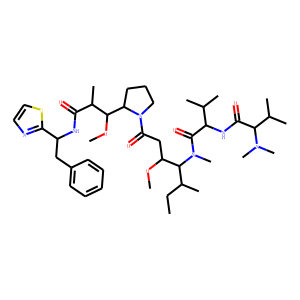| InChI | InChI=1S/C42H68N6O6S/c1-13-28(6)37(47(10)42(52)35(26(2)3)45-40(51)36(27(4)5)46(8)9)33(53-11)25-34(49)48-22-17-20-32(48)38(54-12)29(7)39(50)44-31(41-43-21-23-55-41)24-30-18-15-14-16-19-30/h14-16,18-19,21,23,26-29,31-33,35-38H,13,17,20,22,24-25H2,1-12H3,(H,44,50)(H,45,51)/t28-,29+,31-,32-,33+,35-,36-,37-,38+/m0/s1 |
| Reference | 1. Biochem Pharmacol. 1990 Jun 15;39(12):1941-9. doi: 10.1016/0006-2952(90)90613-p.<br />
Dolastatin 10, a powerful cytostatic peptide derived from a marine animal. Inhibition of tubulin polymerization mediated through the vinca alkaloid binding domain.<br />
Bai R(1), Pettit GR, Hamel E.<br />
Author information:<br />
(1)Division of Cancer Treatment, National Cancer Institute, National Institutes of Health, Bethesda, MD 20892.<br />
Dolastatin 10, a cytostatic peptide containing several unique amino acid subunits, was isolated from the marine shell-less mollusk Dolabella auricularia (Pettit GR, Kamano Y, Herald CL, Tuinman AA, Boettner FE, Kizu H, Schmidt JM, Baczynskyj L, Tomer KB and Bontems RJ, J Am Chem Soc 109: 6883-6885, 1987). Since our preliminary studies demonstrated that dolastatin 10 inhibited tubulin polymerization and the binding of radiolabeled vinblastine to tubulin, an initial characterization of the properties of dolastatin 10 included a comparison to other antimitotic drugs interfering with vinca alkaloid binding to tubulin (vinblastine, maytansine, rhizoxin, and phomopsin A). Dolastatin 10 inhibited the growth of L1210 murine leukemia cells in culture, with a concordant rise in the mitotic index, and its IC50 value for cell growth was 0.5 nM. Comparable values for the other drugs were 0.5 nM for maytansine, 1 nM for rhizoxin, 20 nM for vinblastine, and 7 microM for phomopsin A. IC50 values were also obtained for the polymerization of purified tubulin in glutamate: 1.2 microM for dolastatin 10, 1.4 microM for phomopsin A, 1.5 microM for vinblastine, 3.5 microM for maytansine, and 6.8 microM for rhizoxin. Dolastatin 10 and vinblastine were comparable in their effects on microtubule assembly dependent on microtubule-associated proteins. Preliminary studies indicated that dolastatin 10, like vinblastine, causes formation of a cold-stable tubulin aggregate at higher drug concentrations. We confirmed that rhizoxin, phomopsin A, and maytansine also inhibit the binding of radiolabeled vinblastine and vincristine to tubulin. Dolastatin 10 and phomopsin A were the strongest inhibitors of these reactions, and rhizoxin the weakest. Dolastatin 10, phomopsin A, maytansine, vinblastine, and rhizoxin all inhibited tubulin-dependent GTP hydrolysis. The greatest inhibition of hydrolysis was observed with dolastatin 10 and phomopsin A, and the least inhibition with rhizoxin.<br />
<br />
2. Invest New Drugs. 2005 Oct;23(5):489-93. doi: 10.1007/s10637-005-2909-x.<br />
Phase II trials of dolastatin-10 in advanced pancreaticobiliary cancers.<br />
Kindler HL(1), Tothy PK, Wolff R, McCormack RA, Abbruzzese JL, Mani S, Wade-Oliver KT, Vokes EE.<br />
Author information:<br />
(1)Section of Hematology/Oncology, University of Chicago Medical Center, 5841 South Maryland Avenue, Chicago, IL 60637, USA. [email protected]<br />
BACKGROUND: Pancreaticobiliary malignancies respond poorly to conventional chemotherapy, and novel agents are needed. Dolatstatin-10 is a potent antimitotic pentapeptide isolated from the marine mollusk Dolabella auricularia that inhibits microtubule assembly. We conducted 2 parallel phase II trials of dolastatin-10 in patients with advanced hepatobiliary cancers and pancreatic adenocarcinoma.<br />
PATIENTS AND METHODS: Eligible patients had histologically-confirmed metastatic pancreatic adenocarcinoma or metastatic, locally advanced or recurrent cancer of the liver, bile duct or gallbladder, and had received no prior chemotherapy for advanced disease. Dolastatin-10 400 microg/m(2) was administered intravenously by bolus every 21 days. Restaging CT scans were obtained every 2 cycles. RESULTS: Twenty-eight patients (16 hepatobiliary, including 7 hepatomas, 6 cholangiocarcinomas, 2 gallbladder carcinomas, and 12 pancreatic carcinomas) enrolled; 27 were evaluable for response. There were no objective responses. Grade 3/4 neutropenia occurred in 59% of patients and neutropenic fever in 18%. Median and 1-year survival were 5.0 months and 17% for the pancreatic cancer patients, and 3.0 months and 29% for the hepatobiliary patients. Median time to progression was 1.3 months for the pancreatic cancer patients and 1.6 months for the hepatobiliary patients.<br />
CONCLUSIONS: Dolastatin-10 is inactive against hepatobiliary and pancreatic carcinomas.<br />
<br />
3. Org Biomol Chem. 2017 Jul 26;15(29):6119-6131. doi: 10.1039/c7ob01395g.<br />
A practical approach to asymmetric synthesis of dolastatin 10.<br />
Zhou W(1), Nie XD(1), Zhang Y(2), Si CM(1), Zhou Z(1), Sun X(1), Wei BG(1).<br />
Author information:<br />
(1)School of Pharmacy and Institutes of Biomedical Sciences, Fudan University, 826 Zhangheng Road, Shanghai, 201203, China. [email protected] [email protected]. (2)College of Energy, Xiangan campus of Xiamen University, Xiamen, Fujian 361102, China.<br />
Dolastatin 10, an antineoplastic agent for cancer chemotherapy, is a linear peptide possessing N,N-dimethyl Val-OH, l-valine, (3R,4S,5S)-dolaisoleucine, (2R,3R,4S)-dolaproine and (S)-dolaphenine. Our efficient synthesis includes the following three key features: (1) SmI2-induced cross-coupling was employed to couple aldehyde 11 with (S)-N-tert-butanesulfinyl imine 12 to generate the required stereocenters of Dap (7); (2) asymmetric addition of chiral N-sulfinyl imine 10 provided a straightforward approach to the synthesis of the protected Doe ((S,S)-8); (3) a practical method to the key subunit Val-Dil (24a) has been established as an alternative synthetic route for the synthesis of this challenging chemical structure.<br />
|

